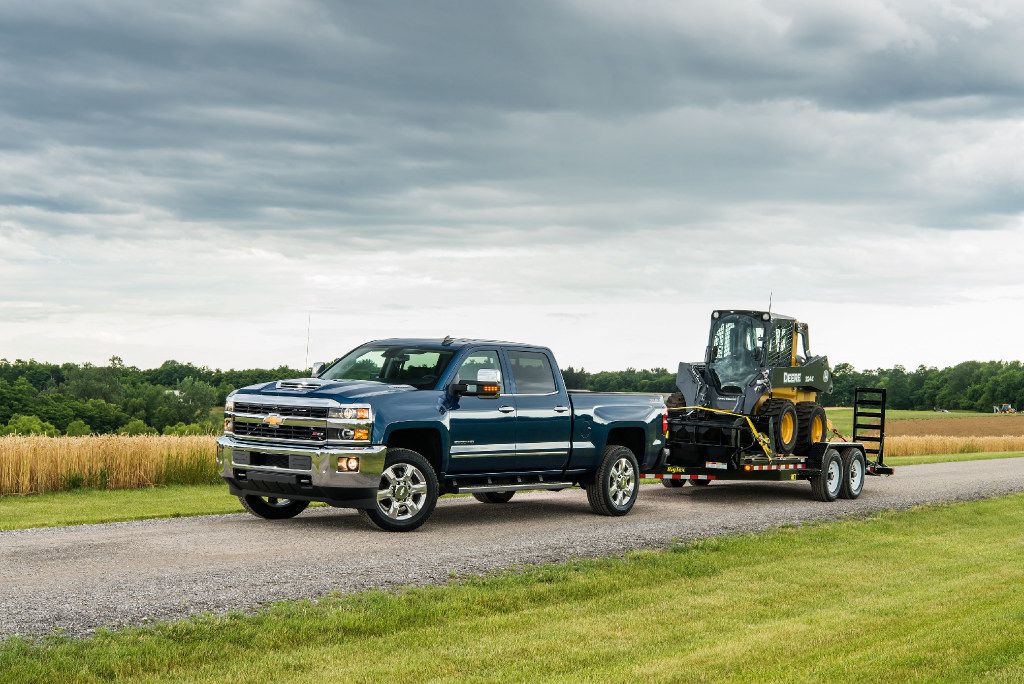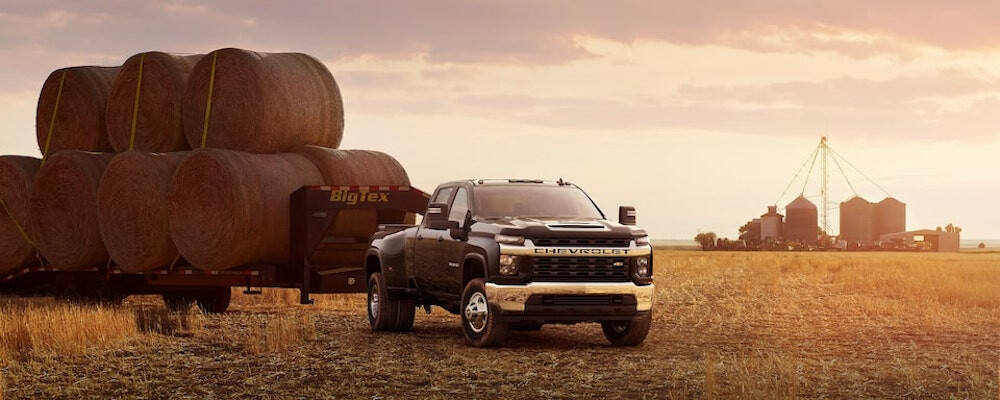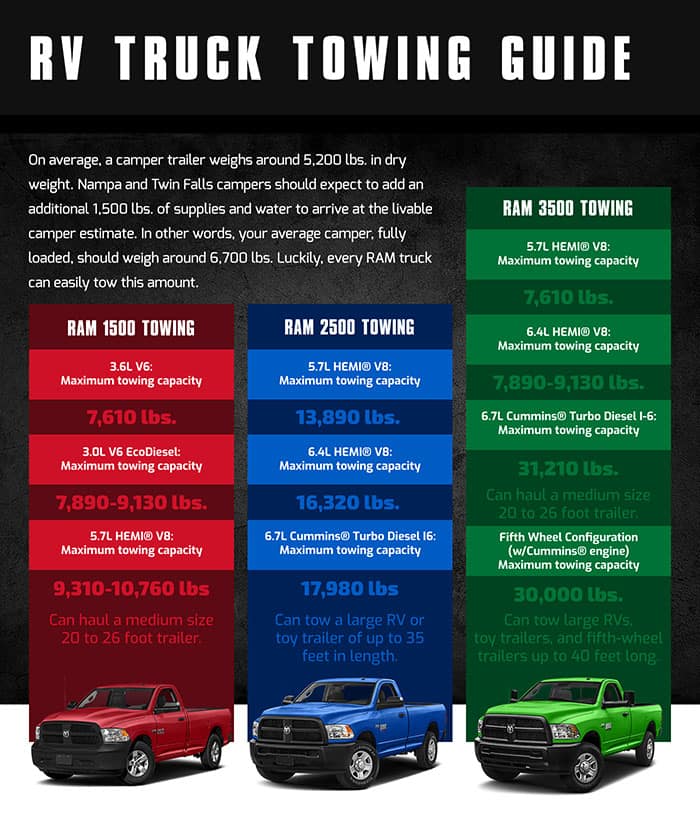In the world of heavy-duty trucks, the question of towing capacity holds essential significance. When it comes to a 2500 truck, the capability to haul substantial weight is often under scrutiny. How much weight can a 2500 truck pull? This question lingers as enthusiasts and professionals seek to understand the true potential of these beasts on wheels. In this article, we will explore the towing capacity of a 2500 truck and delve into the factors that contribute to its impressive pulling power.

This image is property of di-uploads-pod36.dealerinspire.com.
Engine Capacity
The engine capacity of a truck plays a crucial role in determining its towing capabilities. A higher engine capacity generally translates to more power and torque, which are essential for successfully pulling heavy loads. When it comes to towing, it’s crucial to understand two key engine factors: horsepower and torque.
Horsepower
Horsepower refers to the power output of an engine and is an important metric when it comes to determining the towing capacity of a truck. The higher the horsepower, the more power the engine can deliver, allowing it to handle larger loads with relative ease. It is important to note that while horsepower is a significant factor, it should not be the sole consideration when assessing a truck’s towing capabilities.
Torque
Torque is another critical factor that influences a truck’s towing capacity. Unlike horsepower, torque refers to the rotational force produced by the engine. Higher torque values enable the truck to generate more pulling power, particularly at lower engine speeds. This increased pulling power is especially beneficial when hauling heavy loads or tackling steep inclines. When assessing a truck’s towing capacity, it is essential to consider both horsepower and torque to determine its overall capability.
Transmission
The transmission system of a truck is responsible for transferring power from the engine to the wheels. It is instrumental in ensuring smooth acceleration and optimal performance while towing. When evaluating a truck’s transmission, two aspects should be considered: the number of gears and gear ratios.
Gears
The number of gears a truck’s transmission possesses can have a significant impact on its towing capabilities. Generally, trucks equipped with more gears provide a wider range of gear ratios. This allows the engine to operate more efficiently under different load conditions, enhancing the truck’s towing capacity. Additionally, a larger number of gears can help maintain momentum and improve fuel efficiency while towing heavy loads.
Gear Ratios
The gear ratios within a truck’s transmission play a crucial role in translating the power generated by the engine into useful force for towing. Gear ratios determine how much rotational force is delivered to the wheels, enabling the truck to move forward or backward. Trucks with lower gear ratios typically offer more pulling power, allowing them to handle heavier loads. On the other hand, trucks with higher gear ratios are more suitable for highway driving as they offer improved fuel efficiency.
Towing Mode
Many modern trucks come equipped with a towing mode feature in their transmission system. This mode adjusts various settings to optimize the vehicle’s performance while towing. By modifying shift points, throttle response, and other parameters, towing mode ensures that the truck operates at its peak efficiency when hauling heavy loads. Engaging the towing mode can enhance the truck’s towing capacity and provide a more stable towing experience.

This image is property of thumbor-prod-us-east-1.photo.aws.arc.pub.
Differential
The differential is a crucial component of a truck’s drivetrain, responsible for distributing power from the transmission to the wheels. Understanding two key aspects of the differential is essential when considering towing capabilities: rear axle ratio and locking differential.
Rear Axle Ratio
The rear axle ratio refers to the relationship between the number of revolutions the driveshaft makes compared to the number of revolutions of the rear wheels. A lower rear axle ratio typically provides more pulling power, making it beneficial for towing heavy loads. However, it can result in higher engine RPMs, which may impact fuel efficiency. In contrast, a higher rear axle ratio can improve fuel efficiency but may reduce the truck’s towing capacity. Therefore, it is crucial to strike a balance based on the specific towing needs and driving preferences.
Locking Differential
A locking differential is a feature that enhances a truck’s traction and towing capabilities, particularly in off-road or slippery conditions. When engaged, it ensures that power is evenly distributed to both rear wheels, allowing them to rotate at the same speed. This feature can be beneficial when towing on uneven surfaces or dealing with limited traction. By preventing one wheel from spinning freely, a locking differential improves overall stability and enables the truck to gain better traction while towing heavy loads.
Towing Package
A towing package is an optional feature that can enhance a truck’s towing capabilities and provide added convenience when hauling trailers. When considering a truck for towing purposes, it is worth examining the components of its towing package, including the towing hitch and trailer brake controller.
Towing Hitch
A towing hitch is a vital component in securely attaching a trailer to a truck. It typically consists of a trailer receiver and a ball mount, which provide a connection point for the trailer’s coupler. A properly designed and installed towing hitch ensures a strong and secure coupling between the truck and the trailer, allowing for safe and effective towing. When evaluating a truck’s towing capacity, it is essential to consider the type and rating of the towing hitch it is equipped with.
Trailer Brake Controller
When towing heavier trailers, a trailer brake controller becomes an invaluable tool for enhanced safety and control. This device allows the driver to control the trailer’s brakes, independent of the truck’s braking system. With a trailer brake controller, the truck can exert additional stopping power, reducing the strain on its own braking components and providing a more stable towing experience. It is advisable to ensure that a truck is equipped with a trailer brake controller compatible with the type of trailer being towed and that it is properly calibrated for optimal performance.

This image is property of di-uploads-pod3.dealerinspire.com.
Payload and Towing Capacities
Understanding a truck’s payload and towing capacities is vital when selecting a vehicle for towing purposes. These capacities are determined by several factors, including the truck’s Gross Vehicle Weight Rating (GVWR), Gross Combined Weight Rating (GCWR), payload capacity, and towing capacity.
Gross Vehicle Weight Rating (GVWR)
The GVWR refers to the maximum total weight that a truck can safely carry, including its own weight, passengers, cargo, and any attached trailers. It is an essential specification to consider when evaluating a truck’s towing capabilities. The GVWR serves as a guideline to ensure that the vehicle is not overloaded, as exceeding this limit could compromise safety and adversely affect the truck’s performance while towing. Manufacturers specify the GVWR for each truck model, and it is crucial to adhere to these guidelines to maintain a safe and efficient towing experience.
Gross Combined Weight Rating (GCWR)
The GCWR represents the maximum combined weight of a fully loaded truck and any attached trailers. It considers the total weight of the truck, passengers, cargo, trailer tongue weight, and the weight of the trailer itself. The GCWR takes into account the truck’s towing capacity, ensuring that all components can safely handle the load. It is essential to consider the GCWR when evaluating a truck’s towing capabilities to ensure that the combined weight of the truck and trailer falls within acceptable limits.
Payload Capacity
Payload capacity refers to the maximum weight that a truck can safely carry in its bed or cabin. It includes the weight of passengers, cargo, and any additional equipment or accessories. When towing a trailer, the tongue weight, which is the downward force exerted on the hitch ball, is also considered part of the payload. It is crucial to understand a truck’s payload capacity when evaluating its towing capabilities, as exceeding this limit can compromise safety and negatively impact the vehicle’s performance.
Towing Capacity
The towing capacity of a truck specifies the maximum weight it can safely tow. This capacity is influenced by various factors, including the truck’s engine power, transmission, differential, and suspension system. It is important to note that the towing capacity is not solely determined by the truck’s engine size or power output but is also dependent on other key components. When assessing a truck’s towing capacity, it is essential to consult the manufacturer’s specifications and ensure that the weight being towed falls within the designated limits.
Cargo Bed Length and Width
The cargo bed of a truck plays a crucial role when it comes to transporting cargo or hauling equipment. The bed length and width should be considered when evaluating a truck’s suitability for towing purposes.
Bed Length
The bed length refers to the distance from the inside of the truck’s rear bulkhead to the inside of the tailgate. A longer bed length provides more space for accommodating larger items or hauling longer loads, such as lumber or equipment. It is important to consider the intended use of the truck and the type of cargo to be transported when evaluating the bed length. Additionally, the bed length may affect the overall maneuverability of the truck, particularly in tight spaces or urban environments.
Bed Width
The bed width refers to the distance between the truck’s inner wheel wells. A wider bed can facilitate the transportation of wider cargo or provide more space for securing loads. However, it is crucial to ensure that the width of the bed aligns with any specific requirements, such as carrying standard-sized pallets or equipment. Additionally, a wider bed may affect the overall stability of the truck, particularly when towing heavy loads, as it can impact the center of gravity.
Cargo Bed Features
Modern trucks often come equipped with various features designed to enhance the functionality and convenience of the cargo bed. These can include features such as tiedown points, bed liners, cargo management systems, and under-bed storage compartments. When considering a truck for towing purposes, it is worth evaluating the available cargo bed features to determine their suitability for specific towing needs. These features can contribute to a more organized and secure transportation of cargo, ensuring a safe and efficient towing experience.

This image is property of dealerinspire-image-library-prod.s3.us-east-1.amazonaws.com.
Suspension System
The suspension system of a truck is responsible for absorbing shocks and vibrations, providing a smooth and controlled ride. When it comes to towing, different types of suspension systems offer varying levels of stability and load-carrying capabilities. Understanding three common types of suspension systems – coil springs, leaf springs, and air suspension – is essential when evaluating a truck’s towing capabilities.
Coil Springs
Coil springs are a type of suspension system that utilizes helical springs made of coiled steel. They provide a smooth and responsive ride while maintaining excellent weight-carrying capabilities. Trucks equipped with coil springs tend to offer improved stability, particularly when towing heavy loads. Whether used in the front or rear suspension, coil springs are designed to absorb road imperfections and minimize bounce, contributing to a more comfortable towing experience.
Leaf Springs
Leaf springs are a traditional suspension system widely used in trucks due to their durability and load-carrying capabilities. They consist of several layers, or “leaves,” of flexible steel strips, stacked on top of each other and attached to the truck’s frame. Leaf springs offer excellent weight distribution and can handle heavy loads effectively. When towing, leaf springs provide added stability and help minimize body roll, ensuring a smooth and controlled towing experience. However, they may result in a slightly stiffer ride compared to other suspension systems.
Air Suspension
Air suspension is a more advanced suspension system that utilizes air-filled rubber bags instead of traditional coil or leaf springs. It allows for adjustable ride height and stiffness, adapting to different load conditions. Air suspension offers several advantages when it comes to towing, including improved leveling capabilities, enhanced ride comfort, and the ability to adjust the vehicle’s ride height for optimal weight distribution. Trucks equipped with air suspension can provide a more stable and controlled towing experience, particularly when towing heavy and uneven loads.
Braking System
A reliable and efficient braking system is crucial for safe towing. When it comes to trucks, two aspects of the braking system are particularly important: disc brakes and electronic brake controllers.
Disc Brakes
Disc brakes are a type of braking system that utilizes a rotor and caliper assembly to generate friction and slow down or stop the vehicle. These brakes offer superior stopping power and heat dissipation compared to other braking systems, such as drum brakes. Trucks equipped with disc brakes can provide more effective braking performance, especially when towing heavy loads. Additionally, disc brakes are typically less prone to brake fade, ensuring consistent and reliable stopping power even during extended periods of towing.
Electronic Brake Controller
An electronic brake controller is a device that controls the electric brakes on a trailer independently of the truck’s braking system. This controller allows the driver to adjust the amount of braking force exerted by the trailer’s brakes, ensuring optimal control and reducing the strain on the truck’s braking components. Electronic brake controllers are especially beneficial when towing heavier trailers, as they can enhance stopping power and provide a more balanced braking experience. It is important to ensure that the electronic brake controller is compatible with the trailer being towed and properly adjusted for safe and efficient operation.

This image is property of media.assets.ansira.net.
Fuel Efficiency
When evaluating a truck’s towing capabilities, fuel efficiency is an important consideration. Towing heavy loads can significantly impact a vehicle’s fuel consumption. Therefore, understanding the factors that influence fuel efficiency, such as engine efficiency and aerodynamics, is crucial.
Engine Efficiency
Engine efficiency refers to the ability of the engine to convert fuel energy into useful work. Trucks with engines designed for enhanced efficiency can offer better fuel economy, even when towing heavy loads. Features such as direct fuel injection, variable valve timing, and cylinder deactivation can contribute to improved engine efficiency, allowing the truck to exert less effort during towing and consume less fuel.
Aerodynamics
Aerodynamics plays a vital role in minimizing drag and optimizing fuel efficiency, especially when towing. Trucks with streamlined body designs and features such as integrated bed covers, bed caps, or side steps can significantly reduce wind resistance and improve fuel economy. Additionally, accessories like roof-mounted cargo carriers or oversized side mirrors can negatively impact aerodynamics, resulting in increased drag and reduced fuel efficiency while towing. Considering the aerodynamic profile of a truck and any optional accessories is important for maintaining optimal fuel efficiency during towing.
Towing Safety
Ensuring towing safety is of utmost importance for both the driver and other road users. When towing with a truck, several safety features and accessories contribute to a safe and secure towing experience. Three key components to consider for towing safety are trailer sway control, weight distribution hitch, and towing mirrors.
Trailer Sway Control
Trailer sway refers to the side-to-side movement of a trailer while being towed, often caused by external factors such as wind gusts or uneven road surfaces. Trailer sway control systems are designed to mitigate this sway, enhancing stability and control. These systems can automatically apply the trailer’s brakes or adjust the engine’s power output to counteract the sway and help maintain a straight towing path. Trucks equipped with trailer sway control can provide a more secure and confidence-inspiring towing experience, particularly in challenging road or weather conditions.
Weight Distribution Hitch
A weight distribution hitch is an accessory designed to distribute the weight of a trailer more evenly between the truck and trailer axles. When towing heavy loads, the front of the truck can experience excessive weight transfer, leading to reduced steering control and increased strain on the rear suspension. By redistributing the trailer’s weight, a weight distribution hitch helps maintain proper weight balance and alignment between the truck and trailer. This promotes improved stability, better braking performance, and reduced wear on the truck’s suspension components, enhancing overall towing safety.
Towing Mirrors
Towing mirrors play a crucial role in providing the driver with improved visibility of the trailer and surrounding traffic. When towing wider or longer trailers, the standard side mirrors of a truck may not provide sufficient rearward visibility, potentially compromising safety. Towing mirrors offer extended viewing angles, allowing the driver to monitor the trailer’s position and any potential hazards more effectively. Trucks equipped with towing mirrors or those that can be easily added as accessories can significantly enhance safety during towing.
In conclusion, a comprehensive understanding of a truck’s engine capacity, transmission, differential, towing package, payload and towing capacities, cargo bed dimensions, suspension system, braking system, fuel efficiency, and towing safety features is essential when evaluating its towing capabilities. By considering these factors and selecting a truck that aligns with specific towing needs, drivers can ensure a safe, efficient, and enjoyable towing experience. Remember to consult the manufacturer’s specifications and guidelines, and where required, seek professional advice to make informed decisions and maximize the truck’s towing potential.
